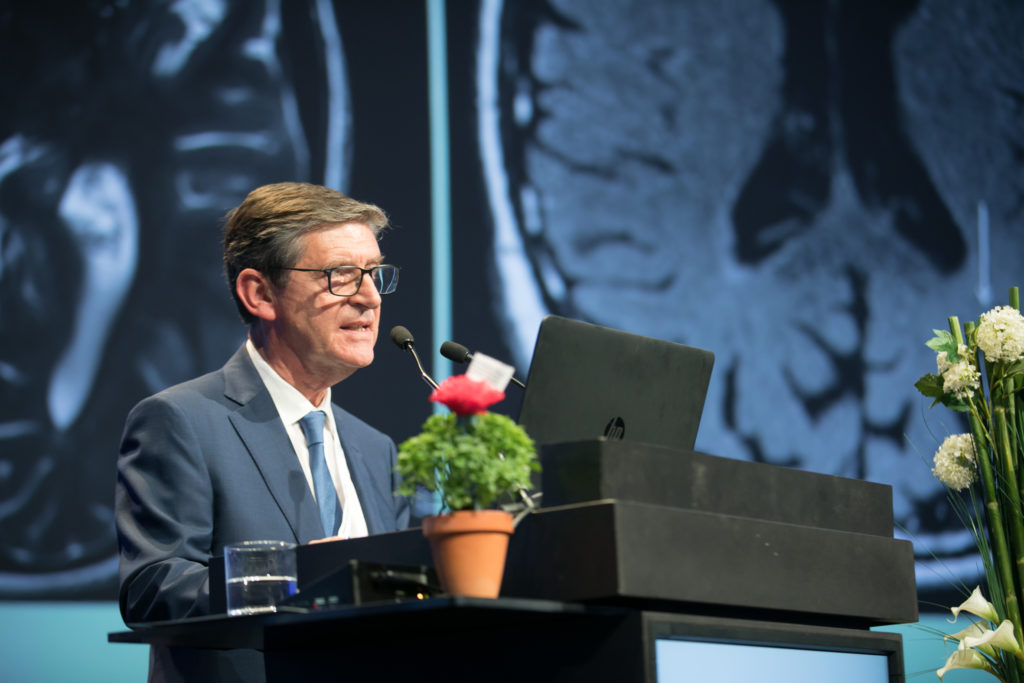Symposium 5: Spectrum of dementias
18 June 2018
By Martin Rakusa
The symposium was chaired by Prof. Jonathan M. Schott from London, United Kingdom, and Prof. Evelien Lemstra from Amsterdam, The Netherlands. Aim of the symposium was to cover four most common dementias – Alzheimer’s disease (AD), vascular dementia, fronto-temporal dementia, and Lewy body dementia.
The symposium was very well attended and only few sits were available for those coming late to the large Auditorium I.
In the first lecture, Prof. Reinhold Schmidt from Graz, Austria, reviewed some current issues on AD. AD starts more than one decade before the first clinical symptoms appear. One of the challenges is to diagnose it earlier. For this reason, criteria for AD were unified in 2011. These criteria were intended for research and clinical trials but not for clinical practice. According to these criteria, AD diagnosis is solely based on biomarkers. Biomarkers are divided into several groups – amyloid beta, tau and neurodegeneration. Levels of the amyloid beta and tau may be evaluated in CSF, serum or with neuroimaging.
The second lecture was on vascular dementia (VD) was given by Prof. José M Ferro from Lisbon, Portugal. He pointed out that VD and vascular cognitive impairment are the second most common reason for cognitive decline. It is most common in low and middle-income countries. The most important risk factor is stroke, followed by other vascular risk factors. The most common pathophysiological mechanism of VD is small vessel disease. He also mentioned the importance of the brain reserve and default brain network. Strategic infarct may impair brain network and lead to the cognitive impairment. At the end, he touched treatment and prevention of VD. One of the interesting findings is that statins do not prevent vascular cognitive impairment.
The third lecture on Frontal Lobe dementias (FLD) was given by Prof. Schott. First, he provided an overview on the different clinical syndromes, underlying pathology and genetics of FLD. He mentioned that in the last twenty years, additional clinical syndromes were included in the FLD group. Beside behavioural variant of FLD, primary progressive aphasia and semantic dementia, progressive supranuclear palsy, corticobasal syndrome and ALS-FLD complex are now included in the FLD group. This change was made based mainly on the underlying pathological changes, not only tau but also ubiquitin and TDP-43. Depending on the study, around 40 % of patients with FLD had positive familial history, with mutation in PGRN, C9ORF72 and other genes. Especially interesting for participants were the videos, where prof. Schott showed patients with different FLD symptoms.
The final lecture was given by Prof. Lemstra on Lewy body dementia (LBD). LBD is the second most common degenerative dementia in the older population. Patients are often misdiagnosed or not even recognised. The severity of their memory impairment varies from day to day. She presented the revised LBD criteria, published last year in Neurology. Patients with LBD do not only suffer from memory impairment but also have other symptoms such as hallucinations, parkinsonism, autonomic dysfunction and sleep disorders. REM sleep behaviour disorders may precede cognitive impairment for a decade. Although pathologically LBD is alpha-synucleinopathy, AD pathology may also occur in different degree. Combined pathology may influence the disease progression and clinical presentation of LBD. It also has an effect on the biomarkers. Until now, we did not have a good method to determine the level of alpha-synuclein in the CSF. Recently, a new technique real‐time quaking‐induced conversion for alpha-synuclein has been introduced, with promising results. The same technique was first used for detecting the prion proteins. In the future, we will see, how useful it is for clinical practice.
In conclusion, all four lecturers gave a great overview and useful information for a daily clinical practice.














